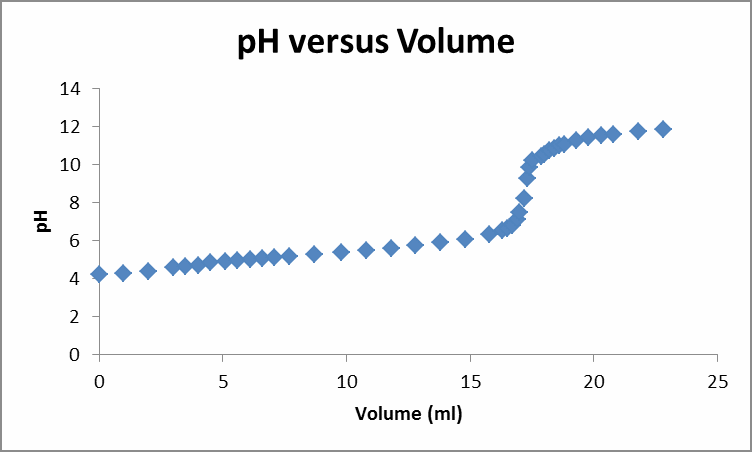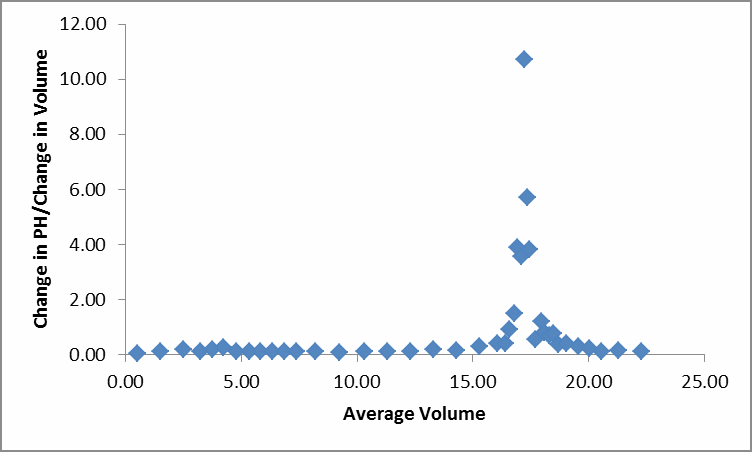Abstract
The experiment aims to determine the equivalent weight and the PKa of KHP acid using potentiometric titration. This is done using a PH meter and a glass electrode. The equivalent weight of monoprotic acid is found to be 1142g while PKa is 5.0 and Ka is 1 x10-5. The acid is weighed out and titrated with a standard solution of sodium hydroxide. The mass of the acid and moles of the base are used to calculate the molar mass of the acid. The titration graphs help to determine the equivalence point, which is 17.5 ml.
Introduction
Equivalent weight is an expression of the number of equivalents in a given amount of substance. The weight is equal to the molecular weight if the acid used is monoprotic. Equivalence point is indicated when there is a sudden rise of the pH in a titration curve. At this point, the weak acid is converted to its conjugate base (Brown 237). Therefore, the concentration of acid is equal to the concentration of its conjugate base.
According to the Henderson Hasselbalch equation,
PH = PKa + log [A-] / [HA]
And [A-] = [HA],
At half volumes, the amounts of HA and A– should be equal. Therefore, this result in the ratio of HA to A– becoming equal, and the log term in the Henderson Hasselbalch equation thus becomes zero. Thus, there is a direct relationship between PKa and pH, as shown below.
Log [A-] / [HA] = 0, thus, PH = PKa
A PH meter is used in the potentiometric titration because of its high sensitivity and ability to convert the voltage caused by H+ in solution to pH readings. One of methods used is potentiometric titration curve, which gives a plot of entire titration curve and, therefore, helps in the allocation of the end point.
Procedure
First, the KHP is removed from the oven and cooled. About 1 g of the acid is weighed on an analytical scale. The mass is recorded to nearest milligrams. The acid is then transferred to a clean 250 ml volumetric flask. Distilled water is added, stirred using a magnetic stirrer to dissolve the acid and filled to the mark. Next, a buret is filled with 50 ml of 0.05M NaOH solution. A pH meter is obtained, and the electrode is rinsed with distilled water and put into the KHP solution. The initial buret reading is recorded, and every portion of NaOH solution is added, as a result, the pH reading is obtained (Grossie 54).
Results


Calculations
From the first derivative graph, the maximum value is 17.5 ml. The half volume is 8.5ml.
From the normal titration graph,
At 8ml, the PH is 4.8
At 9ml, the PH is 5.2
PH = PKa
PKa = 5
Ka = [H3O+] =10pH
1 x 10-5.
Moles of NaOH
It is given by
Ml of NaOH at equivalence point * Molarity of NaOH = (17.5*10-3L)*0.05
8.75 X 10-4 moles
Equivalence point of KHP
Grams of KHP used / Moles of NaOH = 1 / 8.75 X 10-4
1142.8 g/ equiv.
% Error = (1142.8 -204.23)/204.23 = 459%
Discussion
Figures 1 and 2 represent the normal titration graph and the first derivative graph respectively. The sodium hydroxide reacts with the KHP, a monoprotonic acid, according to the following equations:
A–(aq) + H+(aq) Na+(aq) +OH–(aq)↔A–(aq)+ Na+(aq) + H20(l)
At the equivalence point, the moles of the acid and sodium hydroxide are the same as the reaction proceeded to completion the conjugate base is the predominant ion. Although, the derivative method is very precise in locating the end point of an analyte, the results may not be efficient if sufficient data has not been recorded during the rapid increase in the pH.
The errors can result in recording data during the rapid increase of pH as a few drops may result in a higher increase in pH which may not be recorded. The data may not be adequate as it is a manual titration. Errors during the estimation of the equivalence may be seen on the graph. The pH meter could not have been calibrated properly.
The Ka theoretical value of the KBH is 3.9 x 10-6, and the experimental value is 1×10-5.There is a slight difference which may be due to the errors mentioned above. The equivalent weight of the acid is found to be 1132g, and the theoretical value is 204.03g. The difference between the two is very huge. If the pH is not properly calibrated, there will be higher or lower value of pH.
Conclusion
The aim of the experiment has been achieved. Both normal titration graph and first derivative graphs are obtained, and the equivalence point is easily allocated on the graphs.
Works Cited
Brown, Theodore L. Chemistry: the central science. 11th ed. Upper Saddle River, NJ: Pearson Prentice Hall, 2009. Print.
Grossie, David, and Kirby Underwood. Laboratory Guide for Chemistry.7th ed. Dayton: Wright State University, 2014. Print.